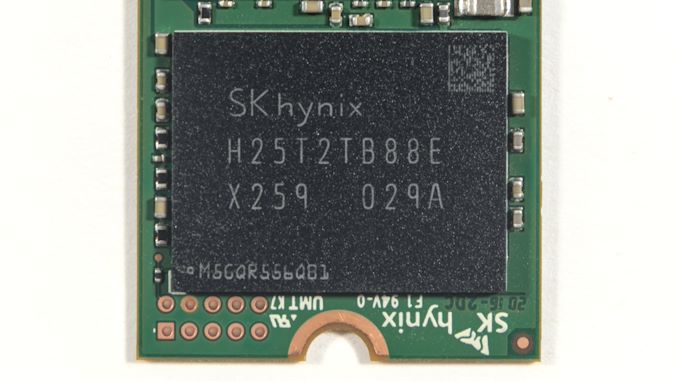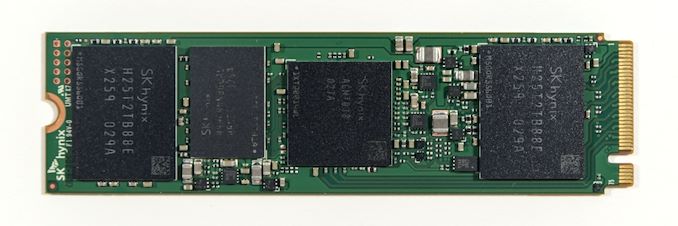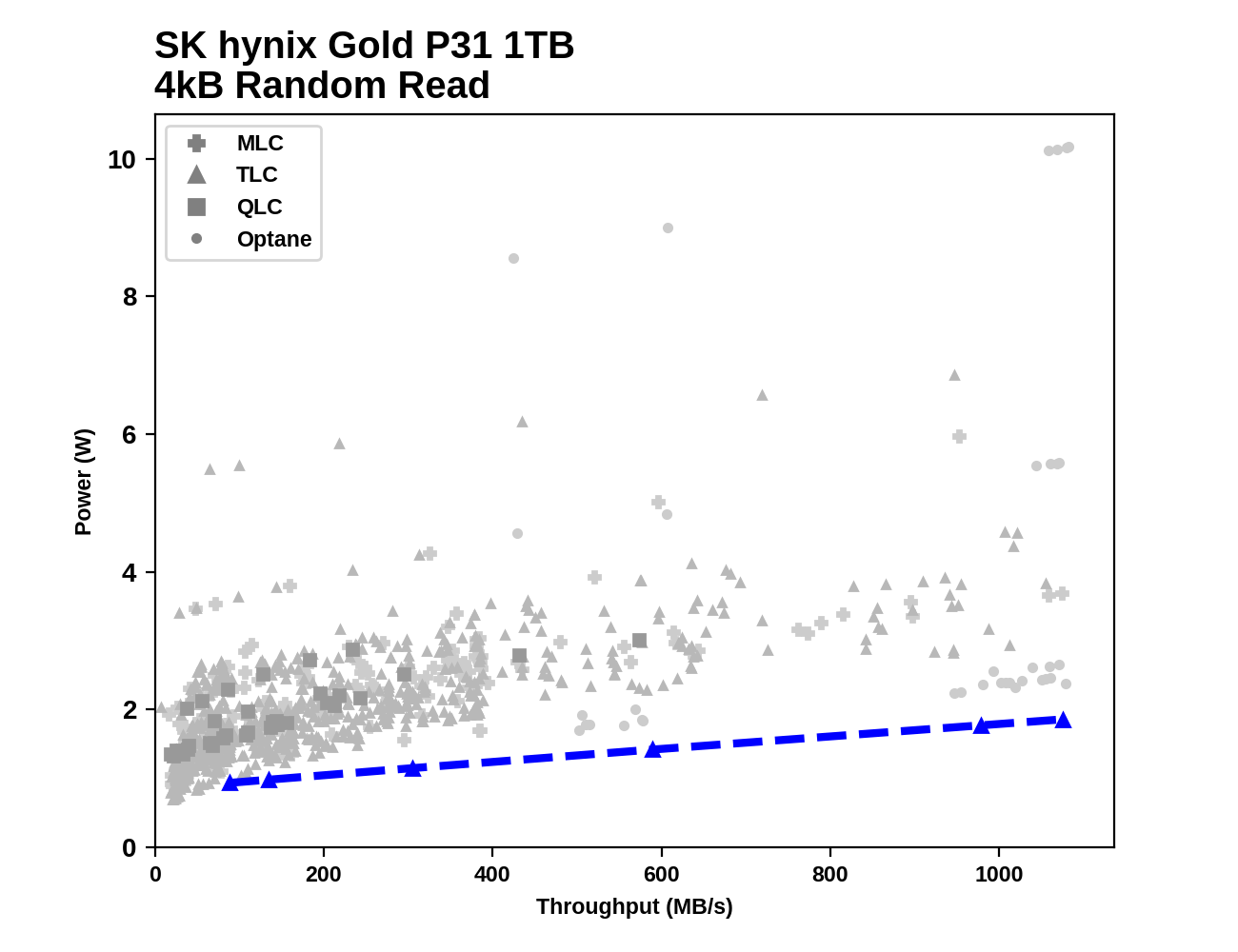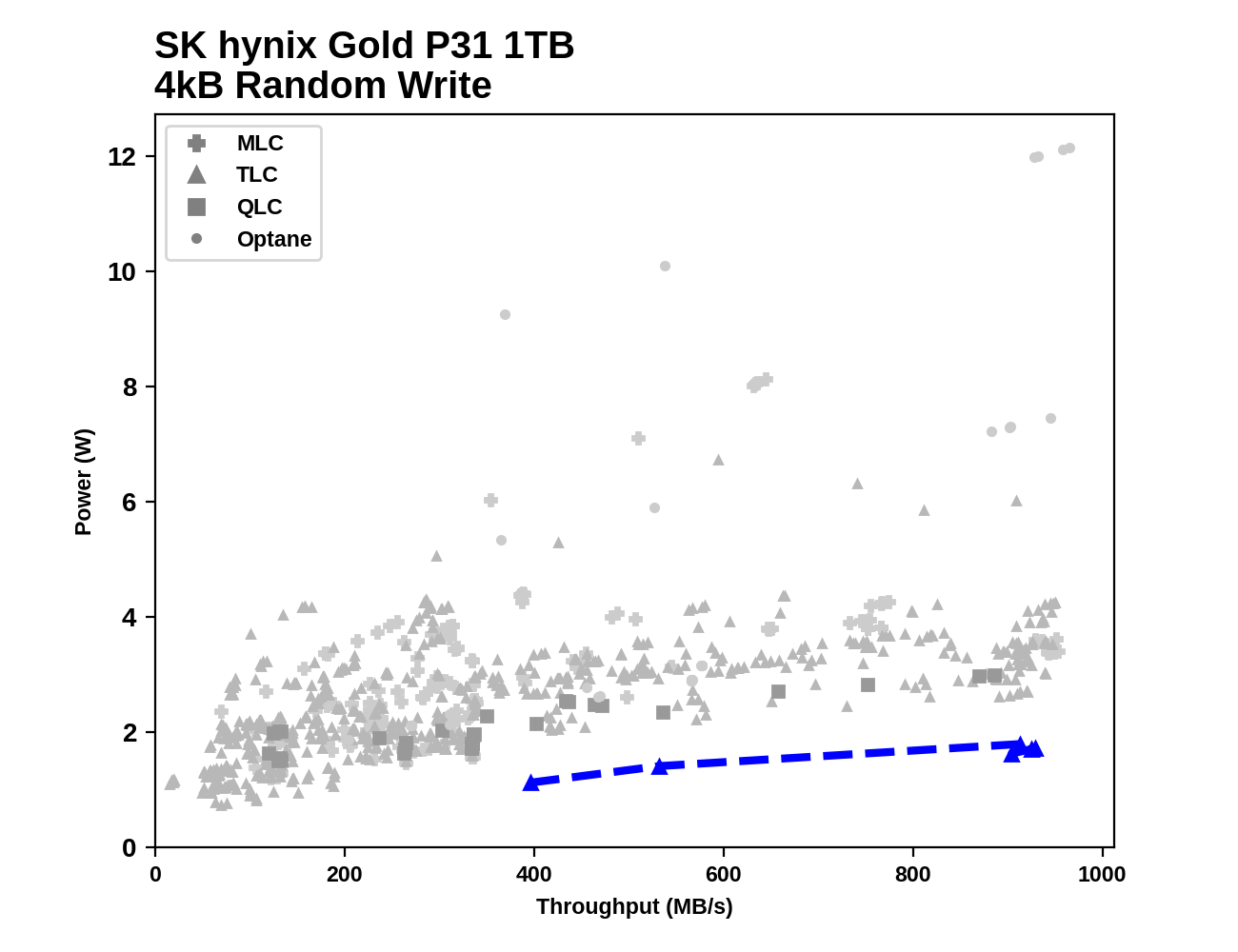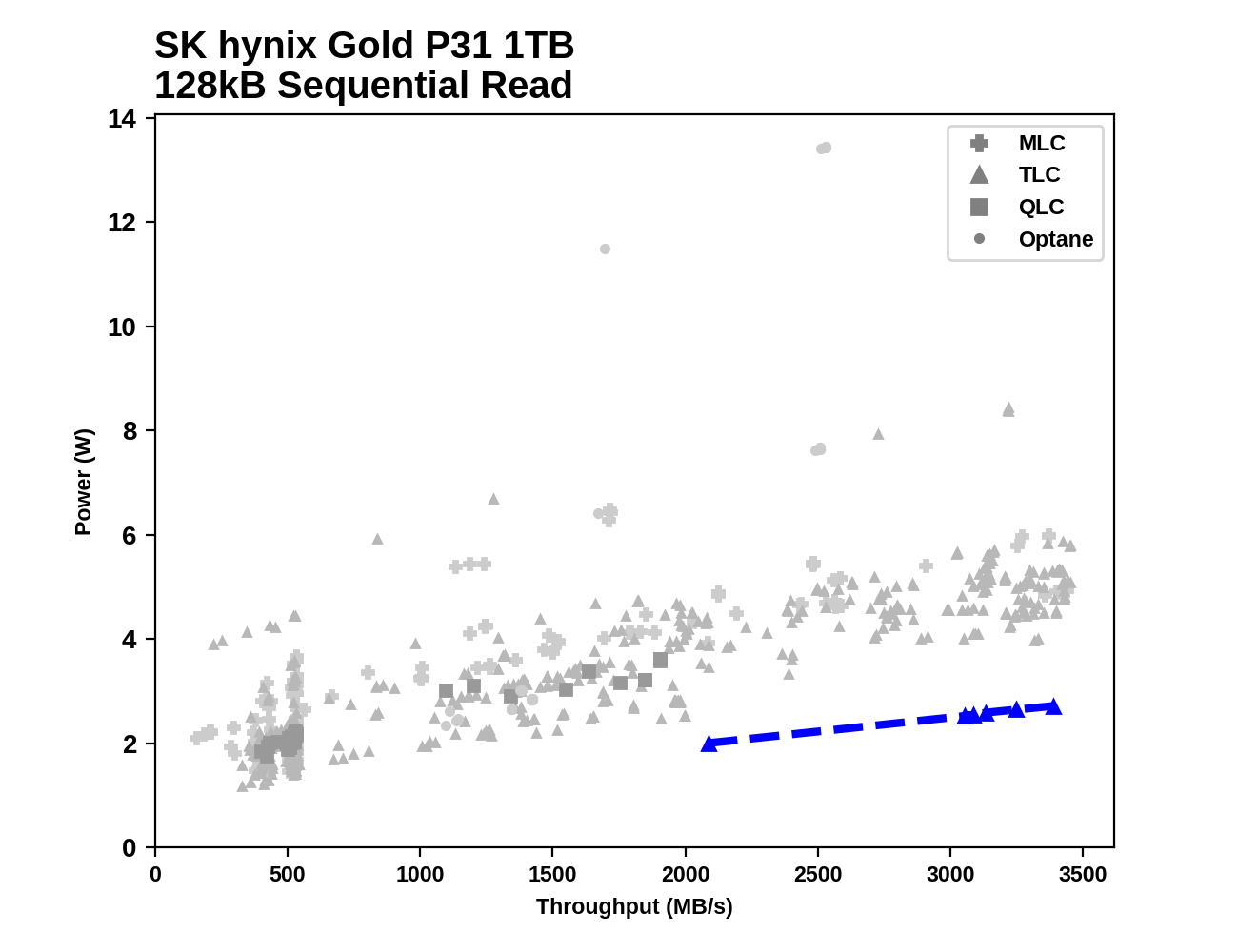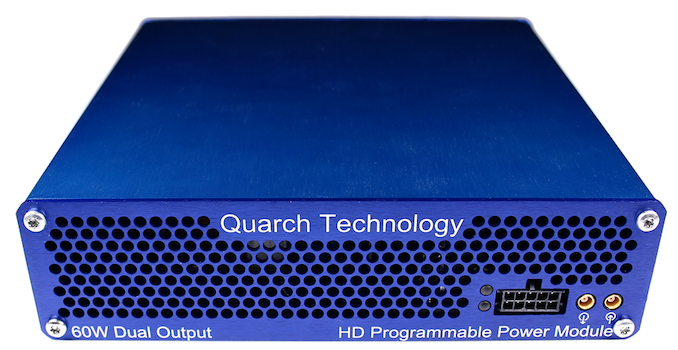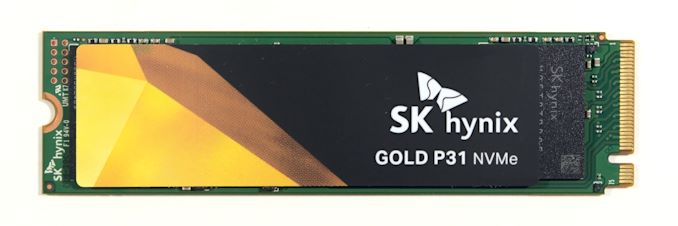
Original Link: https://www.anandtech.com/show/16012/the-sk-hynix-gold-p31-ssd-review
The Best NVMe SSD for Laptops and Notebooks: SK hynix Gold P31 1TB SSD Reviewed
by Billy Tallis on August 27, 2020 8:00 AM EST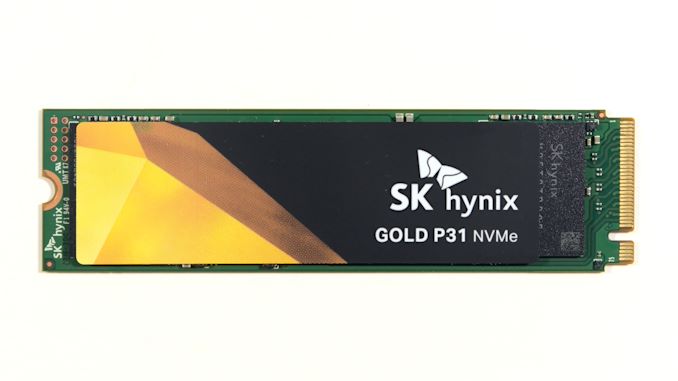
SK hynix is one of the major DRAM and NAND flash memory manufacturers, but for years they've had little to no presence in the retail consumer SSD market and have focused primarily on the OEM market. That started to change last year when they launched their Gold S31 SATA SSDs, but that wasn't really enough to establish SK hynix as an important brand for consumer SSDs. At CES in January, they previewed NVMe SSDs: the Gold P31 and Platinum P31.
When SK hynix PR reached out earlier this month to offer a review sample of the Gold P31 at short notice in advance of last week's launch, I was expecting a fairly straightforward review. Rushed review embargo periods are often a sign that the vendor doesn't want you to spend too much time digging into the details of the product, so I didn't expect the Gold P31 to stand out in any way from the crowd of other PCIe Gen3 NVMe SSDs already on the market. I was expecting that the most interesting facet of the Gold P31 would be the fact that SK hynix actually managed to be first to market with 128L NAND, after years of trying to run ahead of the competition in terms of 3D NAND layer count but with little success in following through in a timely fashion.
The 128L 3D NAND is an important accomplishment, but it turns out to have big consequences for more than just cost. The Gold P31 turned in the most surprising set of benchmark results I've seen, with power efficiency scores that seemed almost too good to be true (more on this later). SK hynix won't share quite as much technical information about these drives as we'd like to have, but they've shared enough to confirm that the Gold P31 does not fit the mold for a typical high-end consumer NVMe SSD.
The Gold P31 offers performance that is competitive with most other high-end consumer SSDs, but it achieves that performance with a very different strategy. For years, the standard formula for this product segment has been the use of TLC NAND with SLC caching, a controller with four lanes of PCIe 3.0 (and starting to move toward PCIe 4.0), DRAM in a ratio of 1 GB per 1TB of flash, and an eight-channel interface between the SSD controller and the NAND flash itself. It's that last piece that the Gold P31 changes, by using just four channels.
NAND Interface Speeds Matter Again
The SK hynix Gold P31 hits high-end performance targets with half the channels by using a much higher IO speed for those channels than we're used to. This NAND interface speed hasn't been an important factor in recent years because an 8 channel SSD can saturate a PCIe 3 x4 host connection with fairly pedestrian NAND interface speeds like 533MT/s. So even though NAND manufacturers and SSD controllers have been moving toward higher interface speeds, it has hardly mattered and has been much less interesting than talking about improvements in latency, power and density.
For the 64-layer 3D NAND generation, NAND interface speeds were typically in the 533-667MT/s range. The extremely popular Phison E12 controller supports up to 667MT/s, but SSDs using Toshiba (now Kioxia) 64L BiCS3 TLC at 533MT/s had no trouble offering good performance—usually only marginally slower than Silicon Motion's SM2262(EN) that supports up to 800MT/s. Now that the NAND market has moved to 96 layers and beyond, most NAND manufacturers can support speeds of 1.2GT/s (1200MT/s) or higher—but those speeds aren't a given. Just like DRAM, NAND chips can come in different speed grades, and not all SSD controllers can handle those speeds yet. SK hynix designs their own SSD controllers, and they updated their controller design to match the capabilities of their 128L NAND, running at 1.2GT/s. This provides plenty of headroom for a 4-channel SSD to saturate a PCIe 3.0 x4 link.
(Side note: The Sony PS5 will use a 12 channel controller, which means it should be able to hit its performance targets with a 533MT/s NAND interface speed. The Xbox Series X is likely using a 4-channel controller, so it will probably need to use a faster NAND interface speed despite the SSD as a whole offering less than half the throughput.)
We're used to seeing 4-channel NVMe SSDs as entry-level products. Those have mostly been using slower NAND interface speeds and offered peak throughput in the ballpark of just 2-2.5 GB/s, and the lower channel count has primarily been a cost-cutting measure (often paired with an elimination of the DRAM buffer to further reduce costs). The SK hynix controller used in the Gold P31 may be cheaper and smaller than the typical 8-channel PCIe gen3 NVMe controller, but it's designed to compete directly against them. SK hynix won't say whether the controller is built on the 28nm process that's used for most PCIe Gen3 NVMe controllers or if they've moved to a smaller FinFET-based node as we're seeing for almost all PCIE Gen4 controller designs. Either way, their controller starts off with a significant power advantage over larger 8-channel controllers.
| SK Hynix Gold P31 SSD Specifications | |||
| Capacity | 500 GB | 1 TB | |
| Form Factor | M.2 2280 single-sided | ||
| Interface | PCIe 3 x4 NVMe | ||
| Controller | SK Hynix in-house | ||
| DRAM | SK Hynix LPDDR4-4266 | ||
| NAND Flash | SK Hynix 128L 3D TLC | ||
| Sequential Read (128kB) | 3500 MB/s | ||
| Sequential Write (128kB) |
SLC | 3100 MB/s | 3200 MB/s |
| TLC | 950 MB/s | 1700 MB/s | |
| Random Read (4kB) | SLC | 570k | |
| TLC | 500k | ||
| Random Write (4kB) | SLC | 600k | |
| TLC | 220k | 370k | |
| Power | Active | 6.3 W | |
| Idle | < 50 mW | ||
| L1.2 Idle | < 5 mW | ||
| Warranty | 5 years | ||
| Write Endurance | 500 TB 0.5 DWPD |
750 TB 0.4 DWPD |
|
| MSRP | $74.99 (15¢/GB) |
$134.99 (13¢/GB) |
|
The SK hynix Gold P31 product line consists of just two capacities: 500GB and 1TB, with only the latter sampled for this review. The Platinum P31 that was announced at CES will be a 2TB model and we expect it to otherwise be identical to the Gold P31, but no further information about the Platinum P31 or its release date is available at this time. SK hynix provides fairly detailed performance specs for the Gold P31: we don't get the low queue depth ratings that matter most, but the high queue depth specs are broken down to show both SLC cache and post-cache TLC performance. The 500 GB model is rated for much lower TLC write speeds than the 1 TB model, but otherwise their performance ratings are similar and typical for a high-end PCIe gen3 drive.
The Gold P31 comes with better than average write endurance ratings: 500 TBW for the 500 GB model and 750 TBW for the 1TB model, putting them both above the standard 0.3 DWPD. Introductory pricing is fairly competitive at $75 and $135.
SK hynix won't confirm details about the NAND other than the layer count and the 1.2GT/s IO speed, but based on their previous announcements about their 128L 3D NAND we believe these are 1Tbit dies, each divided into four planes so they can offer comparable parallelism to 512Gbit dies that are only divided into two planes. (UPDATE: TechInsights insights is analyzing this flash, and it seems to be 512Gbit dies.) With their short-lived 96L generation, SK hynix adopted what they call a PuC: periphery under cell. This is basically the same idea as the Intel/Micron "CMOS under the Array" 3D NAND design, that moves most of the peripheral logic circuitry under the memory cell array, rather than alongside. This design has allowed Intel/Micron 3D NAND to achieve the smallest die sizes for a given layer count and die capacity. Now that SK hynix has adopted this and delivered a leading layer count, they should have one of the most cost-effective TLC parts on the market (provided they're getting good yields). The rest of the major NAND flash manufacturers have a similar technique on their roadmaps.
The Competition
For this review, we are primarily comparing the SK hynix Gold P31 against other high-end TLC-based NVMe drives. Some of these are drives using 64L NAND rather than 96L NAND because we have either been unable to get samples of the newer drives, or we haven't gotten around to testing them. The high-end TLC drives included in this review are:
- Samsung 970 EVO Plus: 92L TLC, same controller as original 970s
- Kingston KC2000: SM2262EN + Toshiba/Kioxia 96L TLC, now replaced by the KC2500 with higher clock speeds
- ADATA XPG SX8200 Pro: SM2262EN + Micron 64L TLC
- Seagate FireCuda 510: Phison E12 + 64L TLC (newer version in the supply chain now uses 96L) and FireCuda 520: Phison E16 + 96L TLC, but restricted to PCIe gen3 on this testbed
- WD Black SN750: High-end NVMe drive with 64L TLC. Until now, our benchmark for most efficient high-end NVMe drive
- Toshiba (now Kioxia) XG6 - The first 96L consumer SSD (OEM only)
We have also included results from a few entry-level NVMe drives:
- Toshiba (now Kioxia) BG4 - low-power DRAMless NVMe, 96L TLC
- Intel 660p - 4-channel SM2263 controller with DRAM, 64L QLC (now replaced by 665p with 96L QLC)
The SK hynix Gold S31 and Samsung 860 EVO SATA drives also included for context.
| AnandTech 2018 Consumer SSD Testbed | |
| CPU | Intel Xeon E3 1240 v5 |
| Motherboard | ASRock Fatal1ty E3V5 Performance Gaming/OC |
| Chipset | Intel C232 |
| Memory | 4x 8GB G.SKILL Ripjaws DDR4-2400 CL15 |
| Graphics | AMD Radeon HD 5450, 1920x1200@60Hz |
| Software | Windows 10 x64, version 1709 |
| Linux kernel version 4.14, fio version 3.6 | |
| Spectre/Meltdown microcode and OS patches current as of May 2018 | |
- Thanks to Intel for the Xeon E3 1240 v5 CPU
- Thanks to ASRock for the E3V5 Performance Gaming/OC
- Thanks to G.SKILL for the Ripjaws DDR4-2400 RAM
- Thanks to Corsair for the RM750 power supply, Carbide 200R case, and Hydro H60 CPU cooler
- Thanks to Quarch for the HD Programmable Power Module and accessories
- Thanks to StarTech for providing a RK2236BKF 22U rack cabinet.
Whole-Drive Fill
This test starts with a freshly-erased drive and fills it with 128kB sequential writes at queue depth 32, recording the write speed for each 1GB segment. This test is not representative of any ordinary client/consumer usage pattern, but it does allow us to observe transitions in the drive's behavior as it fills up. This can allow us to estimate the size of any SLC write cache, and get a sense for how much performance remains on the rare occasions where real-world usage keeps writing data after filling the cache.
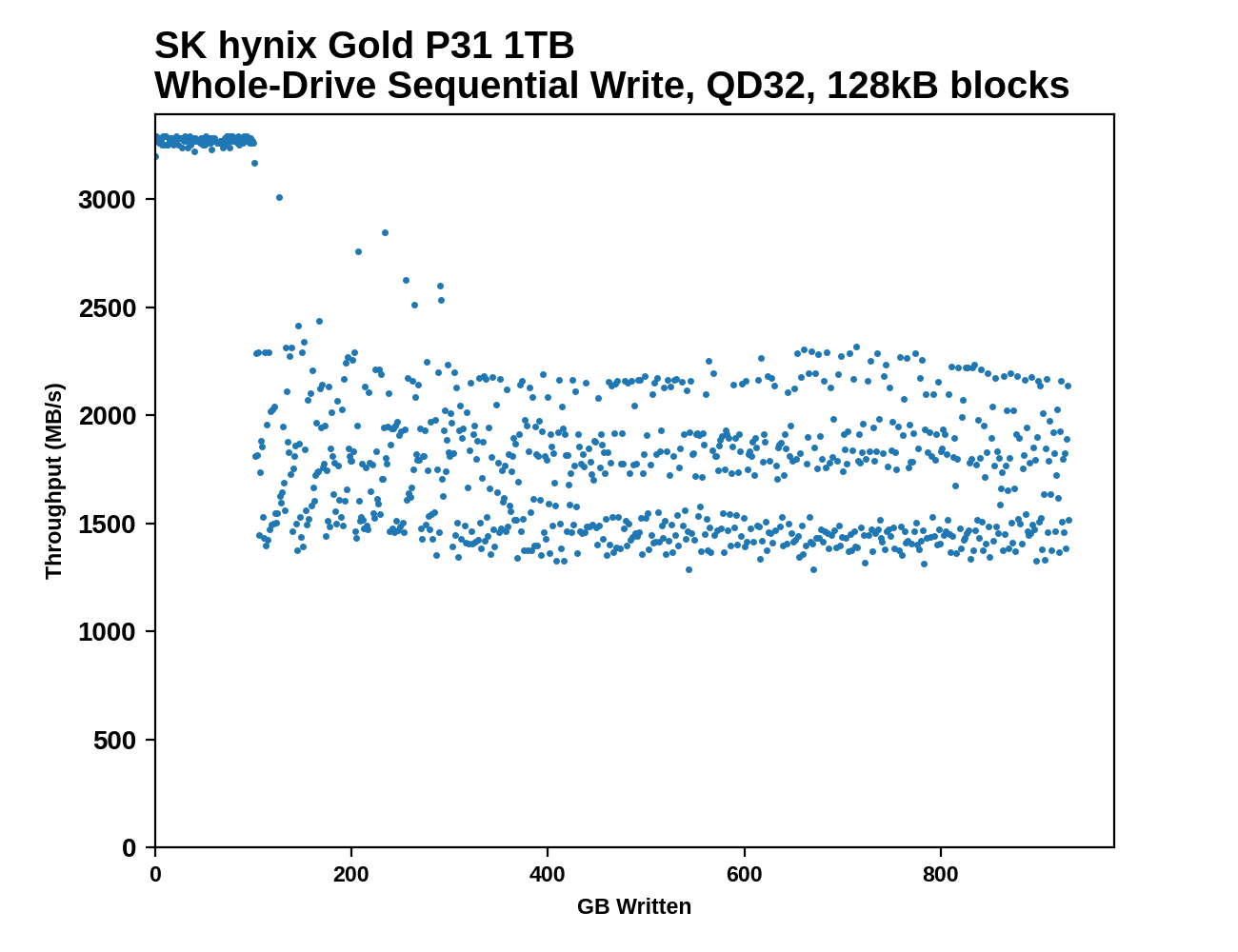 |
|||||||||
The SLC write cache in the 1TB SK hynix Gold P31 runs out after just over 100GB of writes. After the SLC cache fills up, the Gold P31's sequential write performance becomes highly variable, ranging from about 1.4 to 2.3 GB/s with little change in character across the entire TLC filling phase. There are no obvious patterns of periodic garbage collection cycles visible at this scale.
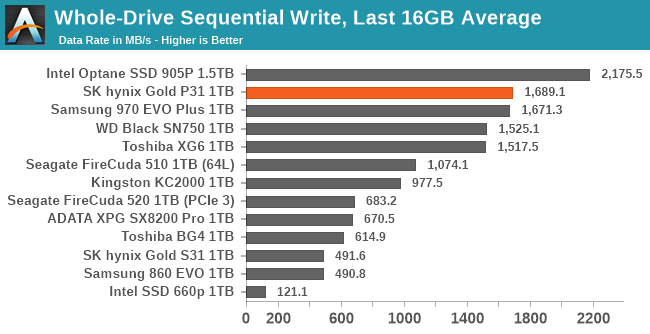 |
|||||||||
| Average Throughput for last 16 GB | Overall Average Throughput | ||||||||
Despite the variability, the P31's long-term sustained write performance is excellent. It averages out to the best overall write throughput we've measured from a 1TB TLC drive, and in all that variation the performance never drops down to a disappointing level.
Working Set Size
Most mainstream SSDs have enough DRAM to store the entire mapping table that translates logical block addresses into physical flash memory addresses. DRAMless drives only have small buffers to cache a portion of this mapping information. Some NVMe SSDs support the Host Memory Buffer feature and can borrow a piece of the host system's DRAM for this cache rather needing lots of on-controller memory.
When accessing a logical block whose mapping is not cached, the drive needs to read the mapping from the full table stored on the flash memory before it can read the user data stored at that logical block. This adds extra latency to read operations and in the worst case may double random read latency.
We can see the effects of the size of any mapping buffer by performing random reads from different sized portions of the drive. When performing random reads from a small slice of the drive, we expect the mappings to all fit in the cache, and when performing random reads from the entire drive, we expect mostly cache misses.
When performing this test on mainstream drives with a full-sized DRAM cache, we expect performance to be generally constant regardless of the working set size, or for performance to drop only slightly as the working set size increases.
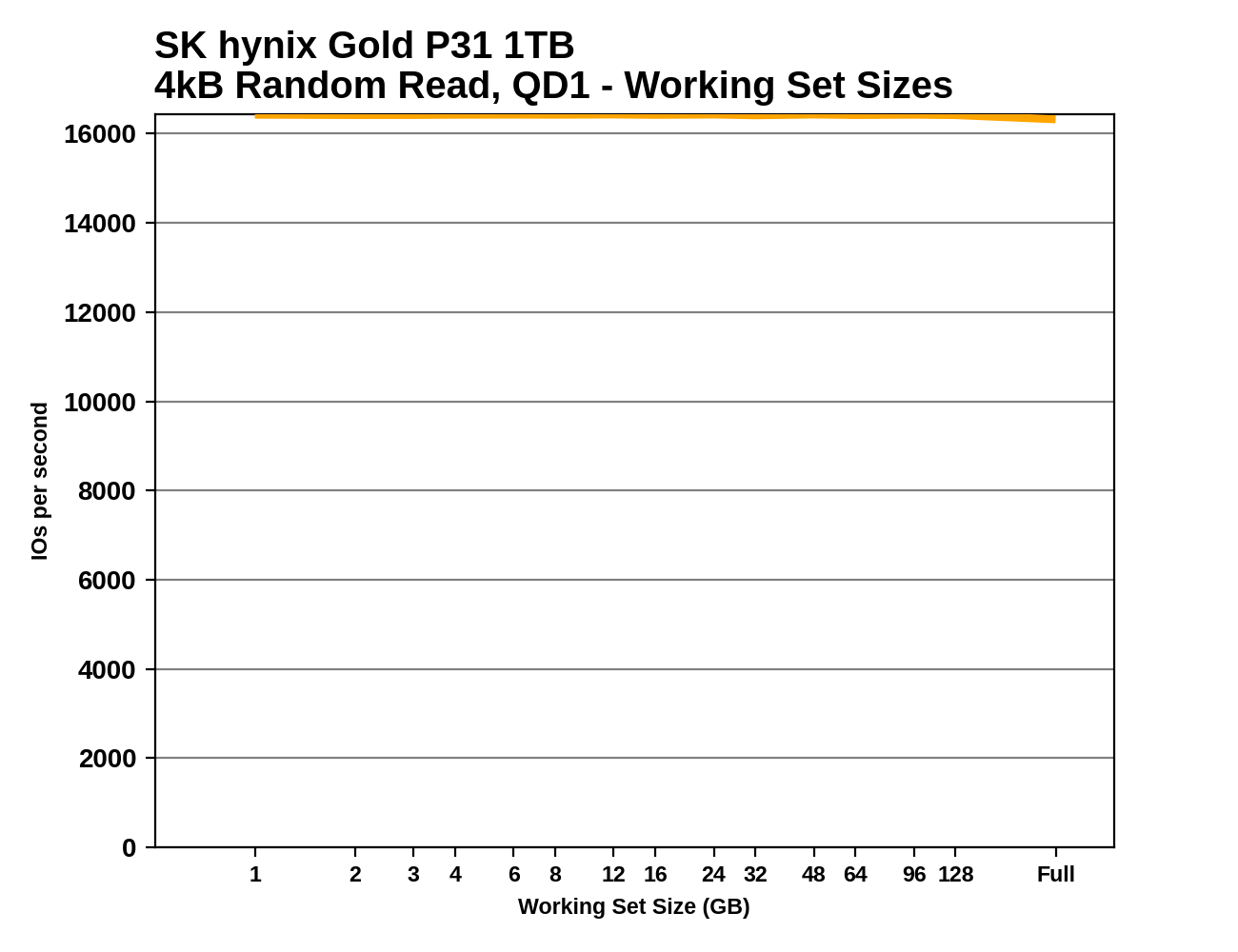 |
|||||||||
As expected for a drive with a full size DRAM buffer, the P31's random read latency is unaffected by spatial locality: reading across the whole drive is just as fast as reading from a narrow range. And the only other TLC drives that can match this read latency are the two Toshiba/Kioxia SSDs with 96L BiCS4 TLC NAND, but they can't maintain this performance across the entire test.
AnandTech Storage Bench - The Destroyer
The Destroyer is an extremely long test replicating the access patterns of very IO-intensive desktop usage. A detailed breakdown can be found in this article. Like real-world usage, the drives do get the occasional break that allows for some background garbage collection and flushing caches, but those idle times are limited to 25ms so that it doesn't take all week to run the test. These AnandTech Storage Bench (ATSB) tests do not involve running the actual applications that generated the workloads, so the scores are relatively insensitive to changes in CPU performance and RAM from our new testbed, but the jump to a newer version of Windows and the newer storage drivers can have an impact.
We quantify performance on this test by reporting the drive's average data throughput, the average latency of the I/O operations, and the total energy used by the drive over the course of the test.
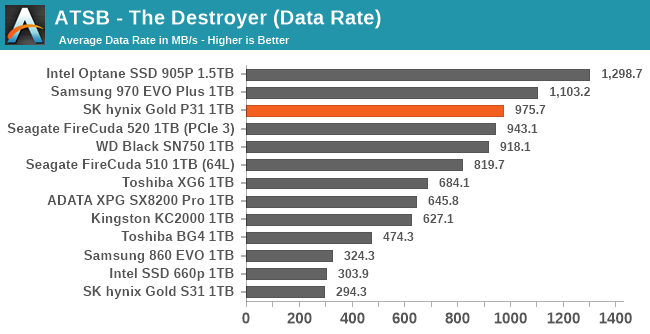 |
|||||||||
| Average Data Rate | |||||||||
| Average Latency | Average Read Latency | Average Write Latency | |||||||
| 99th Percentile Latency | 99th Percentile Read Latency | 99th Percentile Write Latency | |||||||
| Energy Usage | |||||||||
The SK hynix Gold P31 doesn't set any performance records for TLC drives on The Destroyer, but it does deliver top-tier scores on every performance metric—competitive with drives like the Samsung 970 EVO Plus and WD Black SN750.
The energy usage by the P31 is unprecedented: it beats even low-power SATA and DRAMless NVMe drives. The P31 uses 30% less energy over the course of the test than the WD Black SN750, our previous record-holder for most efficient high-performance NVMe SSD. Meanwhile, most of the other fastest drives require two to three times the energy to complete The Destroyer.
AnandTech Storage Bench - Heavy
Our Heavy storage benchmark is proportionally more write-heavy than The Destroyer, but much shorter overall. The total writes in the Heavy test aren't enough to fill the drive, so performance never drops down to steady state. This test is far more representative of a power user's day to day usage, and is heavily influenced by the drive's peak performance. The Heavy workload test details can be found here. This test is run twice, once on a freshly erased drive and once after filling the drive with sequential writes.
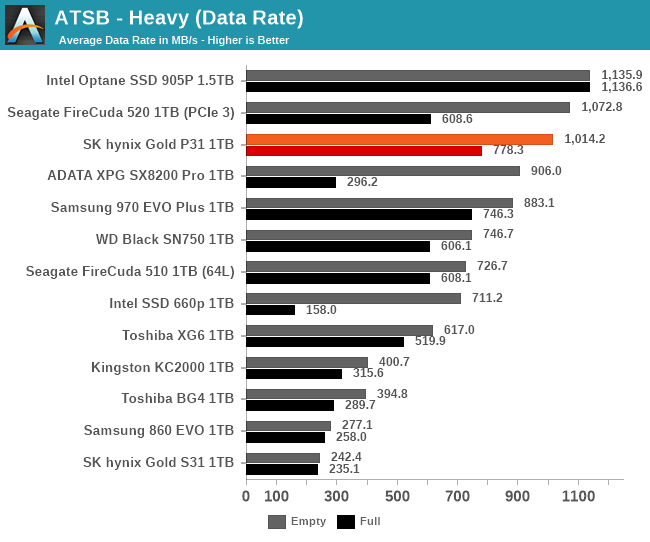 |
|||||||||
| Average Data Rate | |||||||||
| Average Latency | Average Read Latency | Average Write Latency | |||||||
| 99th Percentile Latency | 99th Percentile Read Latency | 99th Percentile Write Latency | |||||||
| Energy Usage | |||||||||
The Gold P31 has great performance on the Heavy test, especially on the full-drive test run where it maintains fast read latencies better while most of the TLC competition falls behind by at least a little bit.
The energy usage of the Gold P31 is again in a different league from other high-end NVMe drives. The Toshiba/Kioxia BG4 is narrowly ahead on this measure, but that's the slowest NVMe drive in this batch. As with The Destroyer, the WD Black's previously class-leading efficiency is beat by at least 30%.
AnandTech Storage Bench - Light
Our Light storage test has relatively more sequential accesses and lower queue depths than The Destroyer or the Heavy test, and it's by far the shortest test overall. It's based largely on applications that aren't highly dependent on storage performance, so this is a test more of application launch times and file load times. This test can be seen as the sum of all the little delays in daily usage, but with the idle times trimmed to 25ms it takes less than half an hour to run. Details of the Light test can be found here. As with the ATSB Heavy test, this test is run with the drive both freshly erased and empty, and after filling the drive with sequential writes.
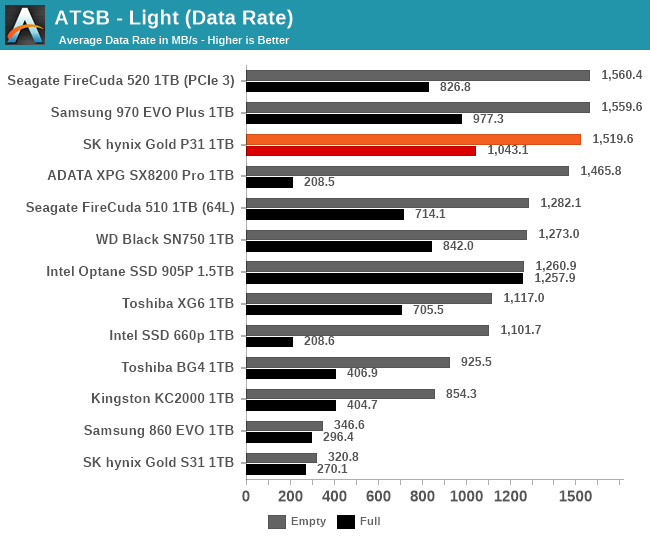 |
|||||||||
| Average Data Rate | |||||||||
| Average Latency | Average Read Latency | Average Write Latency | |||||||
| 99th Percentile Latency | 99th Percentile Read Latency | 99th Percentile Write Latency | |||||||
| Energy Usage | |||||||||
The SK hynix Gold P31's overall performance on the Light test is just a few percent slower than the first-place drives, but as with the Heavy test we see the P31 handling the full-drive test run better than the competition. This time, the P31 doesn't quite manage to beat the energy usage scores from the Toshiba/Kioxia BG4 or its SATA sibling the Gold S31, but compared to the rest of the NVMe drives the story remains the same: the P31 sets a new power efficiency goal for the competition to aim for.
Random Read Performance
Our first test of random read performance uses very short bursts of operations issued one at a time with no queuing. The drives are given enough idle time between bursts to yield an overall duty cycle of 20%, so thermal throttling is impossible. Each burst consists of a total of 32MB of 4kB random reads, from a 16GB span of the disk. The total data read is 1GB.
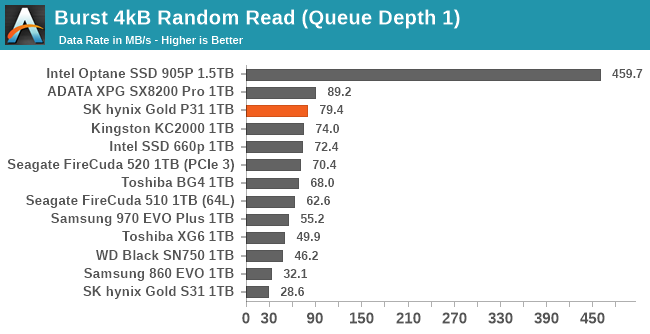
The QD1 burst random read performance of the SK hynix Gold P31 is similar to what we see from drives using the Silicon Motion SM2262EN controller, which has dominated this test since it hit the market.
Our sustained random read performance is similar to the random read test from our 2015 test suite: queue depths from 1 to 32 are tested, and the average performance and power efficiency across QD1, QD2 and QD4 are reported as the primary scores. Each queue depth is tested for one minute or 32GB of data transferred, whichever is shorter. After each queue depth is tested, the drive is given up to one minute to cool off so that the higher queue depths are unlikely to be affected by accumulated heat build-up. The individual read operations are again 4kB, and cover a 64GB span of the drive.
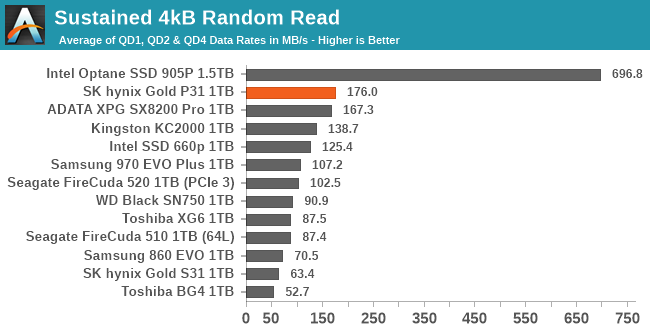
On the longer random read test that reaches into higher queue depths, the Gold P31 pulls narrowly ahead of the SX8200 Pro to set a new record for TLC-based SSDs.
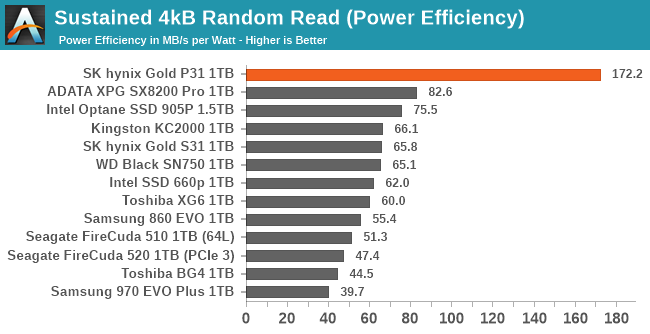 |
|||||||||
| Power Efficiency in MB/s/W | Average Power in W | ||||||||
The power draw of the Gold P31 is only a hair above that of its SATA sibling, the Gold S31. But the P31 is delivering almost three times the performance of that drive, and twice the performance per Watt of the next most efficient drive.
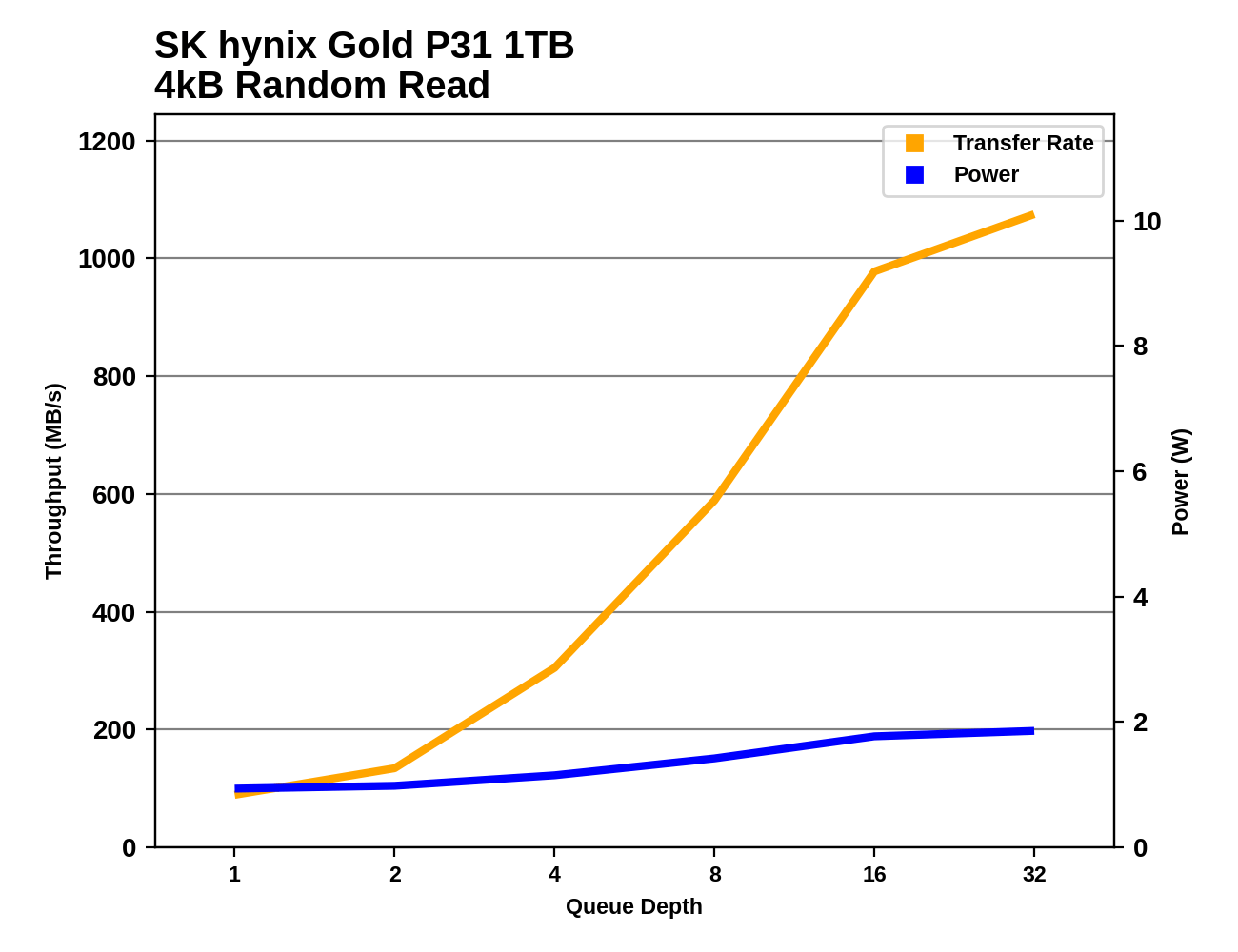 |
|||||||||
The Gold P31 delivers class-leading performance across the entire range of queue depths covered by this test. Its performance is starting to taper off by QD32, but at that point it has caught up with the throughput of the Optane 905P. The widest margins over other TLC SSDs are around QD8 through QD16. Power consumption remains very low throughout the test, not even reaching 2W at QD32 - that 2x efficiency advantage over the competition remains just as true at high queue depths.
Plotting the P31's results against the entire benchmark database shows that the P31 stakes out new territory. The closest competition on the power/performance landscape are the tiny Intel Optane Memory M.2 drives, and at QD4 or higher all the other flash-based SSDs need considerably more power to deliver the same performance (at QD4 and below, the P31 is still in SATA performance territory where there are more low-power competitors).
Random Write Performance
Our test of random write burst performance is structured similarly to the random read burst test, but each burst is only 4MB and the total test length is 128MB. The 4kB random write operations are distributed over a 16GB span of the drive, and the operations are issued one at a time with no queuing.
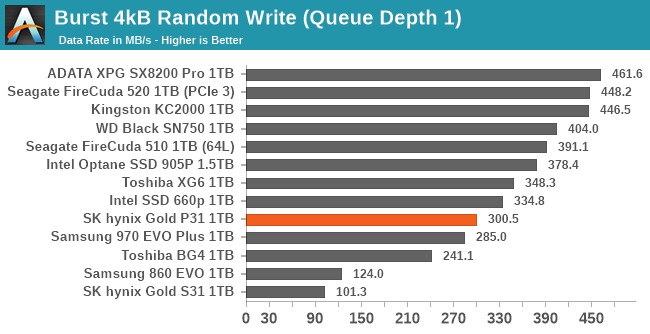
The burst random write performance of the Gold P31 is lackluster: slower than most high-end NVMe drives, though actually still a bit faster than the Samsung 970 EVO Plus.
As with the sustained random read test, our sustained 4kB random write test runs for up to one minute or 32GB per queue depth, covering a 64GB span of the drive and giving the drive up to 1 minute of idle time between queue depths to allow for write caches to be flushed and for the drive to cool down.
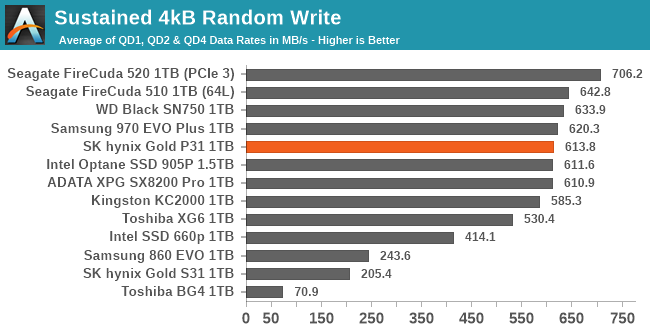
On the longer random write test that includes some higher queue depths, the high-end NVMe drives mostly have fairly similar scores, and the P31 falls in the middle of the pack for performance.
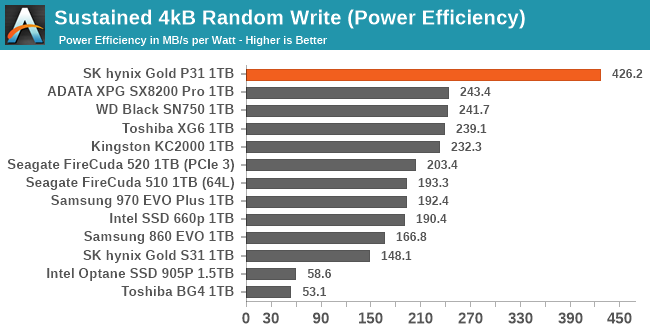 |
|||||||||
| Power Efficiency in MB/s/W | Average Power in W | ||||||||
Once again, the power consumption of the Gold P31 is more in line with low-power SATA or DRAMless NVMe drives, even though it offers high-end performance. This time, the efficiency score isn't quite twice that of the next best competitor, but a 75% improvement is still impressive.
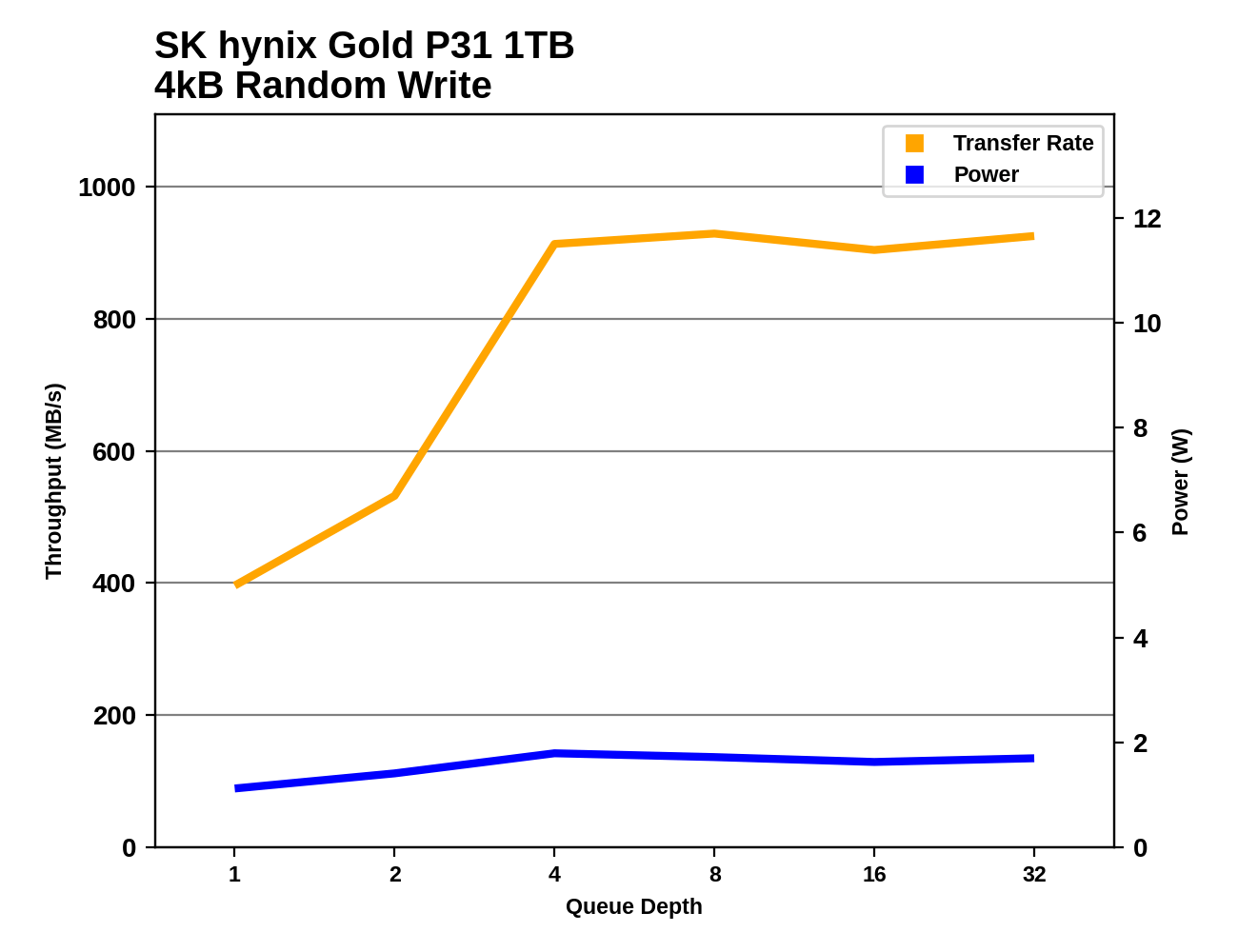 |
|||||||||
The performance profile for the Gold P31 on the random write test is fairly typical: fill performance is reached at QD4, and performance is mostly steady through the rest of the test. The P31 starts out slightly slower at QD1, but at full speed it is definitely competitive.
Comparing the Gold P31's random write performance against our entire database of results shows it standing out even more clearly than it did for the random read results. The QD1 random write performance is already beyond the reach of SATA drives, and none of the other NVMe drives we've tested operate at such low power levels.
Sequential Read Performance
Our first test of sequential read performance uses short bursts of 128MB, issued as 128kB operations with no queuing. The test averages performance across eight bursts for a total of 1GB of data transferred from a drive containing 16GB of data. Between each burst the drive is given enough idle time to keep the overall duty cycle at 20%.
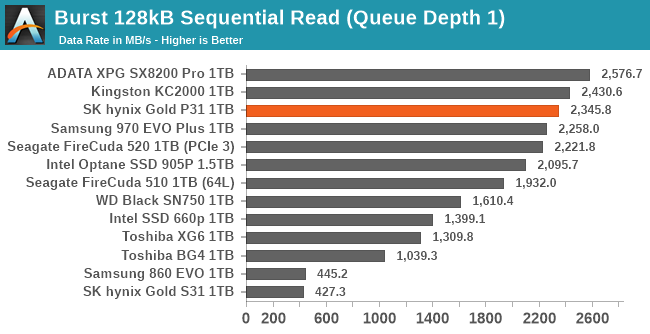
The burst sequential read performance from the SK hynix Gold P31 is very good, but not quite fast enough to beat the drives based on the Silicon Motion SM2262EN controller.
Our test of sustained sequential reads uses queue depths from 1 to 32, with the performance and power scores computed as the average of QD1, QD2 and QD4. Each queue depth is tested for up to one minute or 32GB transferred, from a drive containing 64GB of data. This test is run twice: once with the drive prepared by sequentially writing the test data, and again after the random write test has mixed things up, causing fragmentation inside the SSD that isn't visible to the OS. These two scores represent the two extremes of how the drive would perform under real-world usage, where wear leveling and modifications to some existing data will create some internal fragmentation that degrades performance, but usually not to the extent shown here.
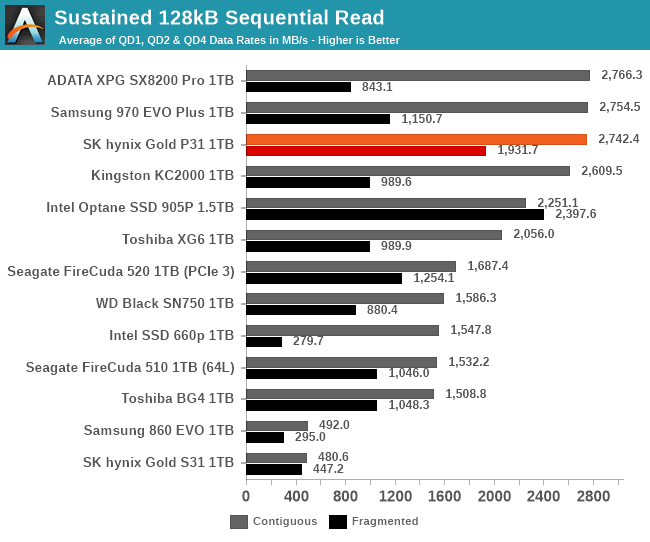
On the longer sequential read test that involves some slightly higher queue depths, the Gold P31 is basically tied for first place when reading data that was written sequentially. When reading data that has previously been fragmented by the random write test, the P31's performance is considerably higher than the other flash-based SSDs and closer to the Optane 905P.
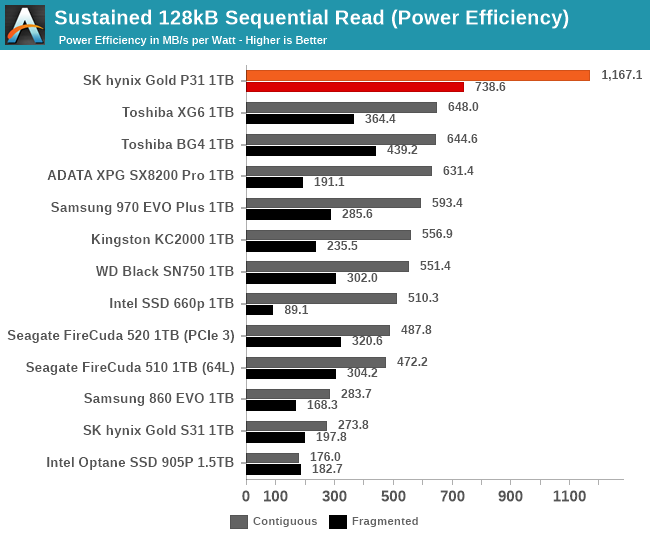 |
|||||||||
| Power Efficiency in MB/s/W | Average Power in W | ||||||||
In absolute terms, the power consumption of the Gold P31 isn't drastically lower than some of the other fairly efficient high-end NVMe drives like the WD Black SN750. But once performance is taken into account, the Gold P31's efficiency stands far above the competition.
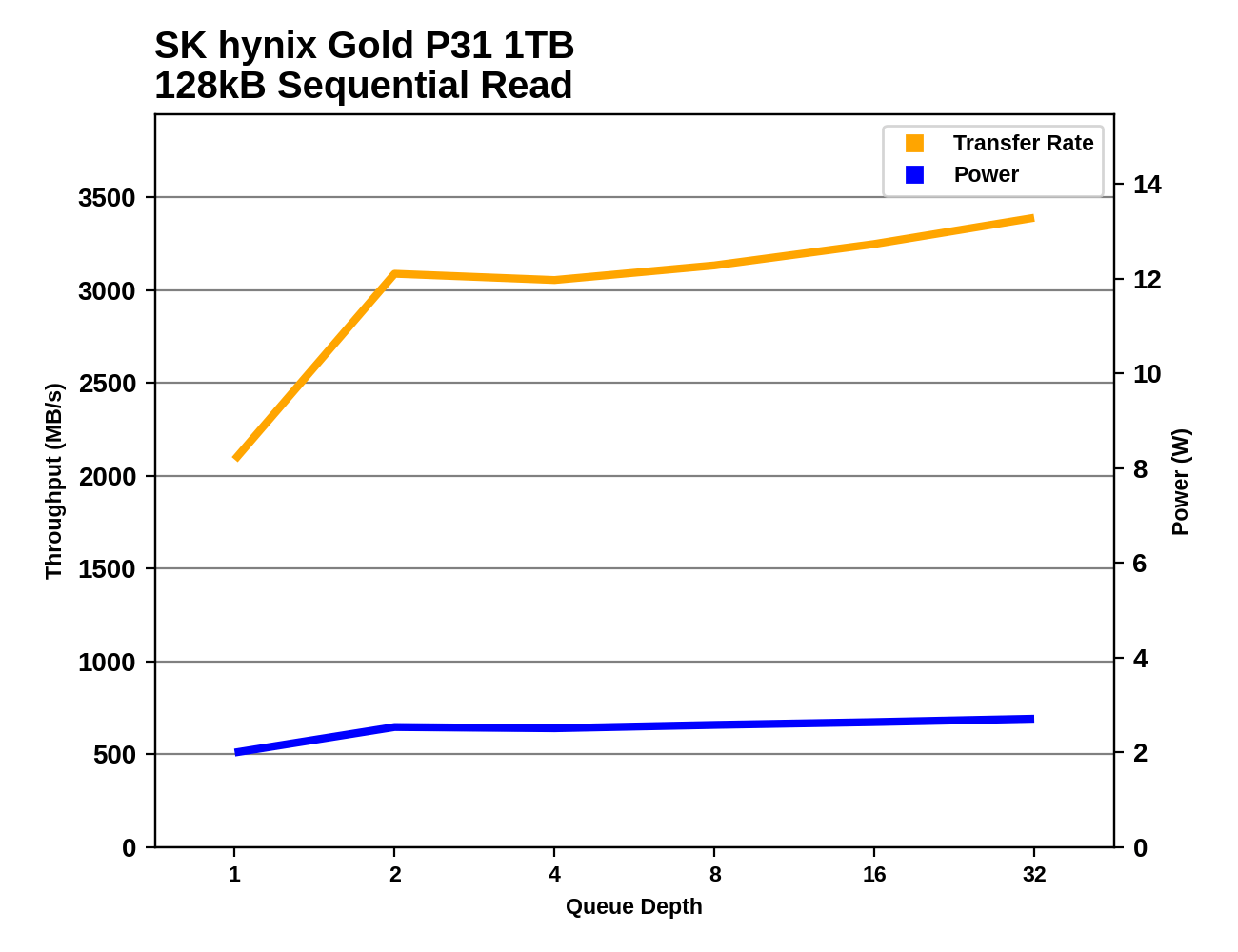 |
|||||||||
The SK hynix Gold P31 doesn't need high queue depths to deliver good sequential read throughput: at QD2 it's already above 3 GB/s, but there are further slight performance increases from higher queue depths. That performance profile is very similar to the Samsung 970 EVO Plus, but that drive requires about twice the power that the P31 uses.
Even at QD1, the sequential read performance from the Gold P31 is above the ~2GB/s limit of most other four-channel NVMe drives we've tested (with eg. Silicon Motion SM2263 based controllers). That leaves it entirely in a performance range where all the competitors are 8-channel drives that don't come close to matching power efficiency of the Gold P31.
Sequential Write Performance
Our test of sequential write burst performance is structured identically to the sequential read burst performance test save for the direction of the data transfer. Each burst writes 128MB as 128kB operations issued at QD1, for a total of 1GB of data written to a drive containing 16GB of data.
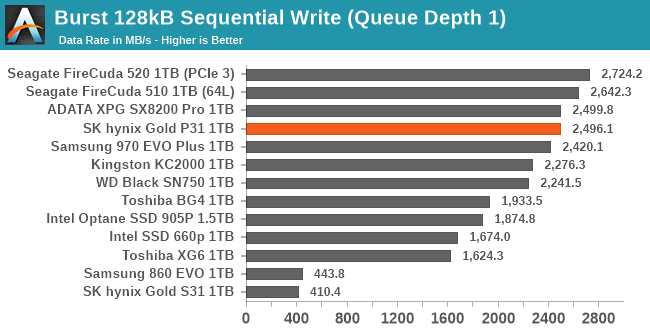
The SK hynix Gold P31 has fairly ordinary burst sequential write performance by high-end NVMe standards: tied with the SM2262EN-based ATATA SX8200 Pro but beat by the Phison-based Seagate drives.
Our test of sustained sequential writes is structured identically to our sustained sequential read test, save for the direction of the data transfers. Queue depths range from 1 to 32 and each queue depth is tested for up to one minute or 32GB, followed by up to one minute of idle time for the drive to cool off and perform garbage collection. The test is confined to a 64GB span of the drive.
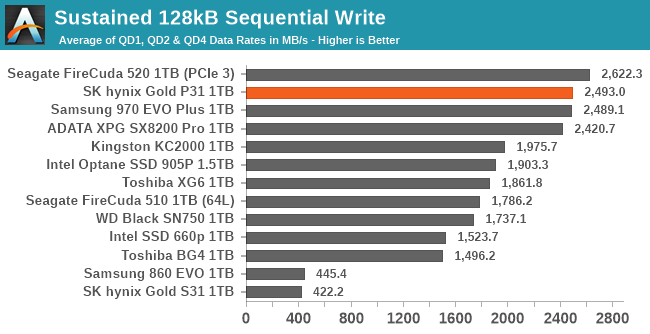
On the longer sequential write test that brings in higher queue depths, the Gold P31 is tied for second place, while the Phison E16 based Seagate drive (built for PCIe 4 speeds, but limited by this testbed to PCIe 3 speeds) unsurprisingly takes first place.
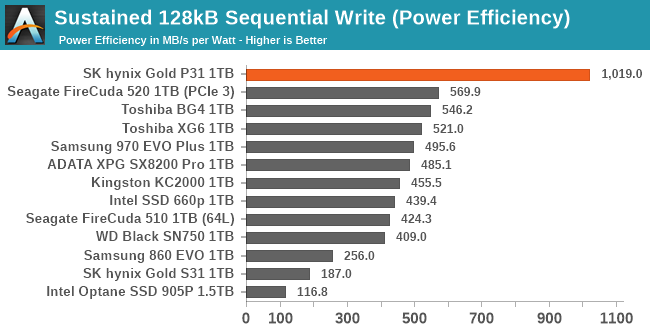 |
|||||||||
| Power Efficiency in MB/s/W | Average Power in W | ||||||||
At this point, the record-shattering power efficiency scores from the SK hynix Gold P31 are no longer a surprise. The overall fastest drive has the second best efficiency score (56% the performance per Watt of the P31) and the next two most efficient drives are much slower NVMe drives from Toshiba/Kioxia.
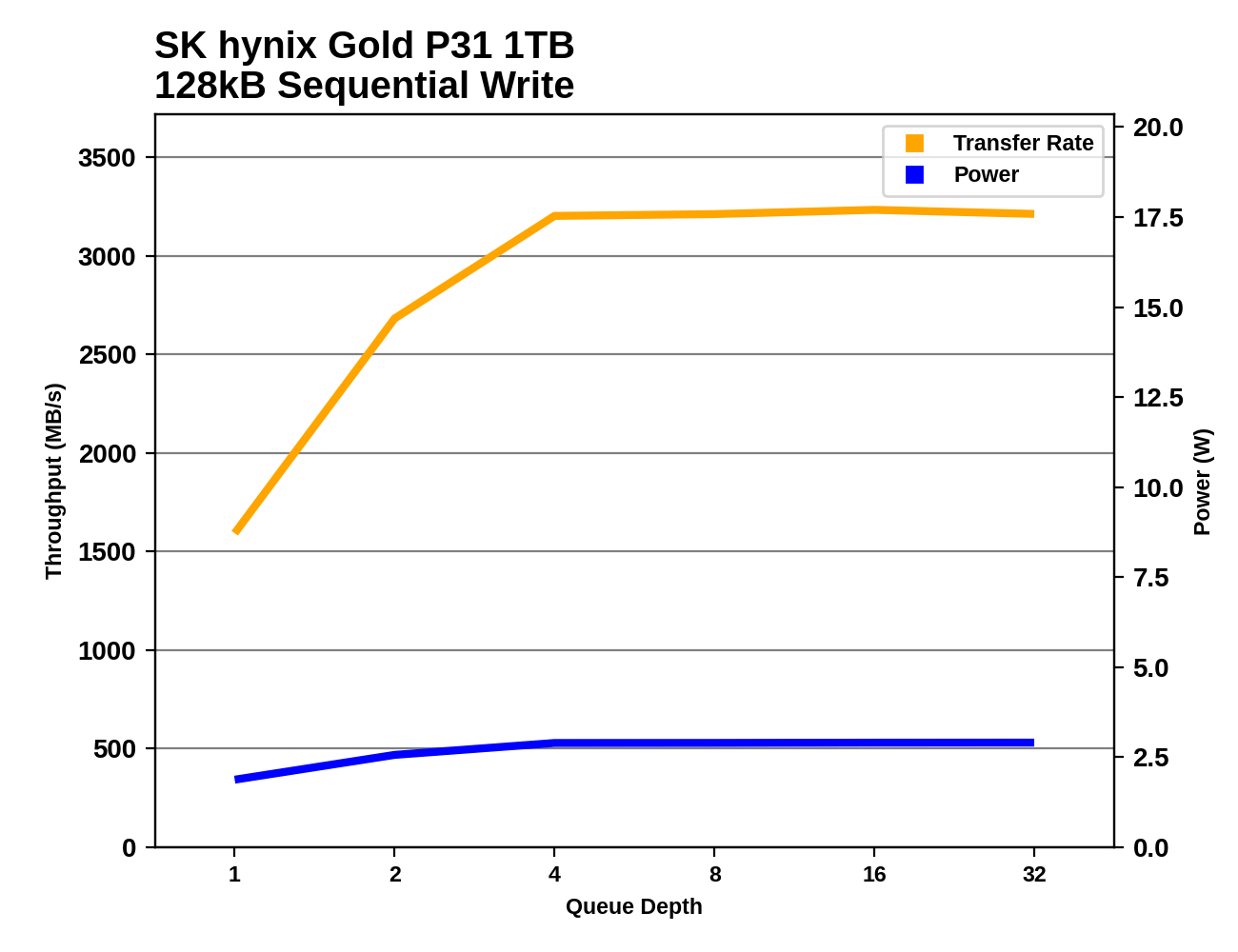 |
|||||||||
The Gold P31 doesn't reach its full sequential write speed until QD4, while several of its competitors saturate at QD2. However, once the P31 is at full speed, it has one of the best sustained write speeds, and shows no sign of its SLC cache running out at any point during the test. Power consumption is comparable to the slowest NVMe drive that can barely hit half the throughput of the Gold P31.
Similar to the sequential read results, the P31 starts out at QD1 with high performance that almost puts it beyond what other 4-channel NVMe drives can do at any queue depth. From there, the P31 continues to redefine what's possible with an increasingly wide lead in power consumption relative to all other high-end drives we've tested.
Mixed Random Performance
Our test of mixed random reads and writes covers mixes varying from pure reads to pure writes at 10% increments. Each mix is tested for up to 1 minute or 32GB of data transferred. The test is conducted with a queue depth of 4, and is limited to a 64GB span of the drive. In between each mix, the drive is given idle time of up to one minute so that the overall duty cycle is 50%.
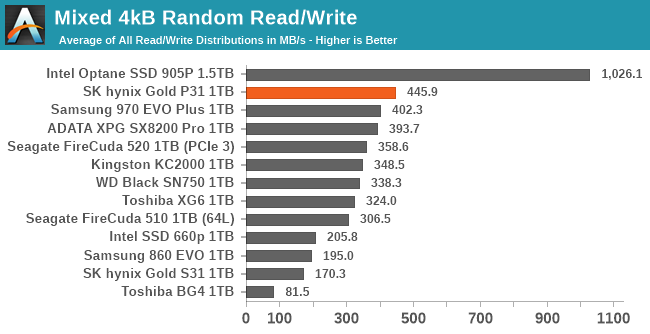
The Intel Optane 905P holds on to a very comfortable performance lead on our mixed random IO test, but the SK hynix Gold P31 raises the bar for TLC-based SSDs by about 10%.
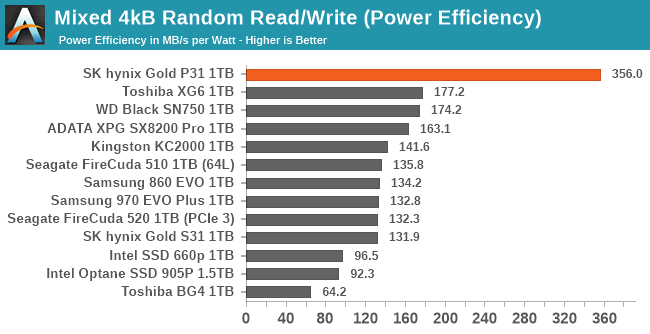 |
|||||||||
| Power Efficiency in MB/s/W | Average Power in W | ||||||||
The Gold P31 has the lowest average power consumption on this test out of all the drives in this batch, which naturally leads to a massive lead in power efficiency: it delivers twice the performance per Watt of the next best drive.
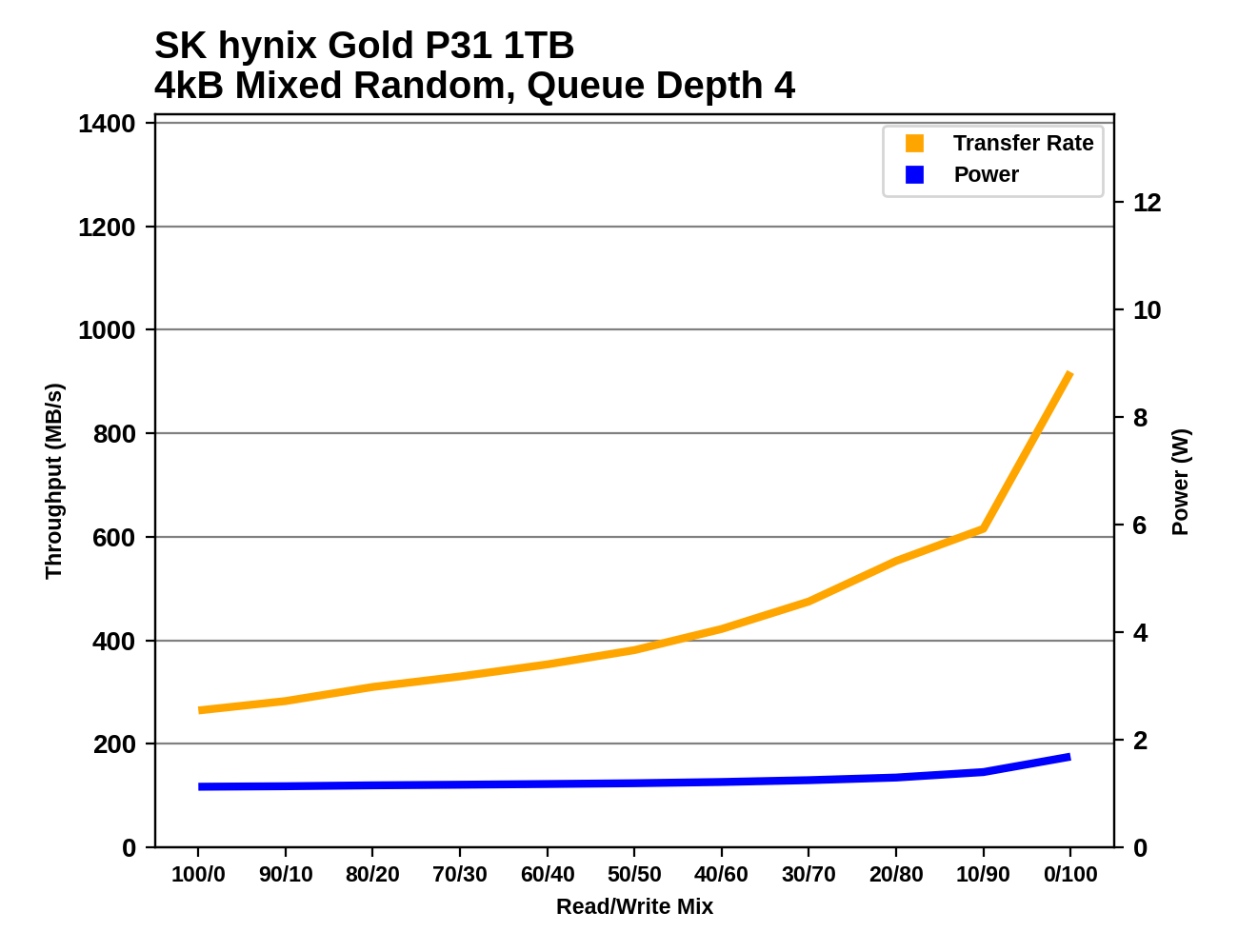 |
|||||||||
Compared to other high-end TLC-based SSDs, the Gold P31 performs best during the more read-heavy phases of this test. Several competitors catch up to it and a few surpass it during the most write-intensive portions of the test, but that also tends to be where the P31's power usage advantage is widest.
Mixed Sequential Performance
Our test of mixed sequential reads and writes differs from the mixed random I/O test by performing 128kB sequential accesses rather than 4kB accesses at random locations, and the sequential test is conducted at queue depth 1. The range of mixes tested is the same, and the timing and limits on data transfers are also the same as above.
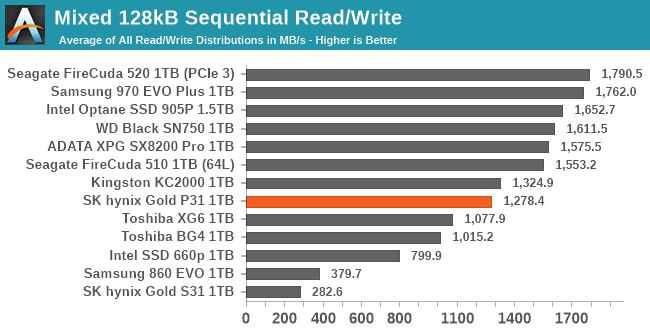
The mixed sequential read/write performance of the SK hynix Gold P31 is unimpressive. For once, its performance is about what we'd expect from a drive designed more for efficiency than raw performance. However, it still has an 18% lead over the slowest 8-channel drive in this batch.
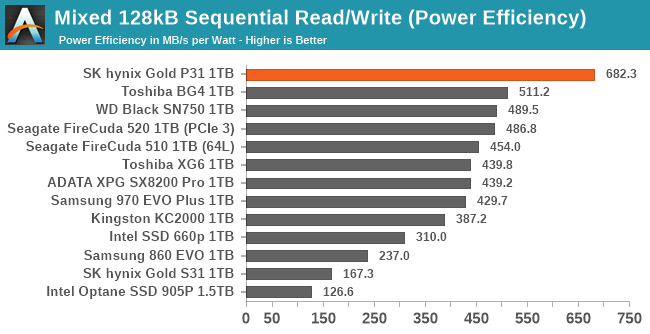 |
|||||||||
| Power Efficiency in MB/s/W | Average Power in W | ||||||||
The Gold P31 still completes this test with remarkably low power consumption (averaging less than 2W), but the relatively modest performance means its efficiency score is only about 33% above the next best drive in this bunch.
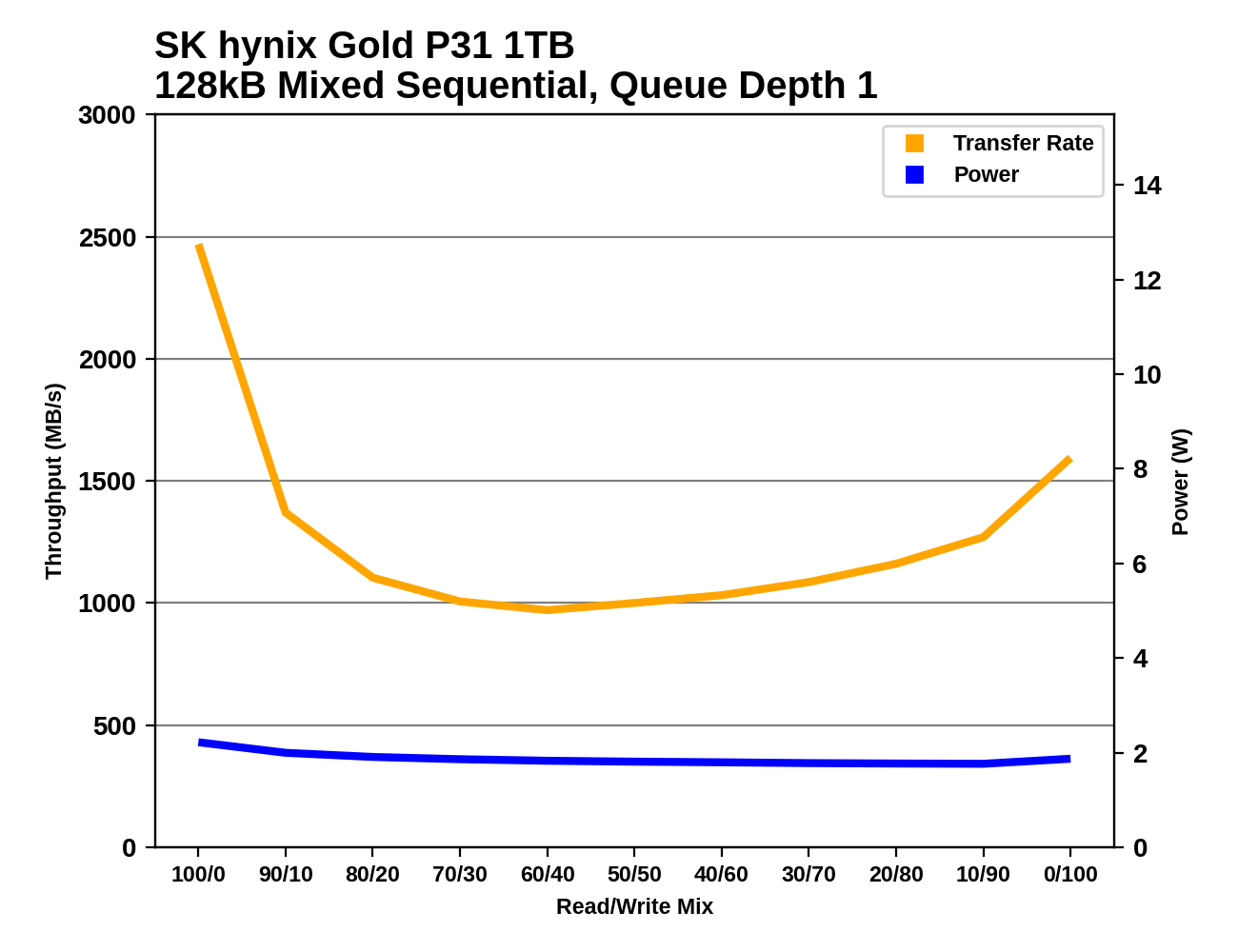 |
|||||||||
After starting out with a good sequential read speed, the SK hynix Gold P31's performance drops steeply when writes are added to the mix. It bottoms out just below 1GB/s with a 60% reads mix, and then gradually recovers performance to finish with a fairly typical sequential write speed. Power consumption from the P31 doesn't vary much across the test, and it's only above 2W at the very beginning of the test.
Power Measurement Sanity Check
Our current SSD test suite is almost completely automated. There are only about a dozen points where manual intervention is required to go from plugging in the drive to having a directory full of graphs ready to be analyzed and uploaded for the review. This helps ensure the tests are highly repeatable, and makes it easier to run a drive through the 24+ hours of testing without losing too much sleep. But things can still occasionally go wrong, and that's what I assumed had happened when I first looked at the test results for the SK hynix Gold P31. The power efficiency scores were way out of the normal range for high-end NVMe drives, and I worried that something was amiss with our very fancy and expensive Quarch HD Programmable Power Module (PPM).
After completing the initial round of testing for the P31, I took several steps to validate the surprising results. First, checking that the PPM wasn't reporting any error codes, and that the graphs were generated from the right data (rather than something like plotting measurements from the 12V supply rail for a 3.3V-only M.2 drive). Then, verifying that the PPM still produced reasonable results for a drive we've previously tested, because we've been using this instrument since April 2019 without any recalibration. I put the Samsung 970 EVO Plus 1TB back on the testbed and re-ran some idle and load power measurements, which produced virtually identical results to our original measurements—confirming that the PPM is still accurately reporting instantaneous power draw.
At this point, it was looking pretty certain that the record-setting efficiency scores from the Gold P31 were genuine, but there were still a few semi-plausible failure modes that could have affected at least some of the tests. For example, on the ATSB tests we report the total Watt-hours of energy used by the drive over the course of the test. If the power log was truncated before the test finished, that could quite easily lead to a much lower total energy usage number—but the power log for The Destroyer contained a normal 7h20m of data (and most of our scripts to process the logs and generate graphs try to detect a truncated log).
To make sure there wasn't anything really strange going on behind the scenes, I re-ran all of the Linux-based synthetic benchmarks with the Quarch Power Studio application open and graphing the power measurements in realtime:
Ignoring the labels on the vertical axis, this all looks as expected. The different phases of the tests are very distinct, with the drive dropping down to reasonable idle power levels between phases, and load power steadily increasing with queue depth. The tests that involve writing data show that the drive's power consumption jumps up after the host system is finished writing, when the SSD flushes the SLC cache in the background. (Our current synthetic tests don't directly measure this phenomenon, but it's typical behavior.) But even so, the largest spikes visible at this scale (samples averaged into 131ms chunks) only hit 4W. It was at this point that I started pressing SK hynix for more details about the controller and NAND used in the P31, to see how they pulled off such impressive efficiency:
 |
|||||||||
| Random Read | Random Write | Mixed Random I/O | |||||||
| Sequential Read | Sequential Write | Mixed Sequential I/O | |||||||
Power Management Features
Real-world client storage workloads leave SSDs idle most of the time, so the active power measurements presented earlier in this review only account for a small part of what determines a drive's suitability for battery-powered use. Especially under light use, the power efficiency of a SSD is determined mostly be how well it can save power when idle.
For many NVMe SSDs, the closely related matter of thermal management can also be important. M.2 SSDs can concentrate a lot of power in a very small space. They may also be used in locations with high ambient temperatures and poor cooling, such as tucked under a GPU on a desktop motherboard, or in a poorly-ventilated notebook.
| SK hynix Gold P31 1TB NVMe Power and Thermal Management Features |
|||
| Controller | SK hynix ACNT038 | ||
| Firmware | 41060C20 | ||
| NVMe Version |
Feature | Status | |
| 1.0 | Number of operational (active) power states | 3 | |
| 1.1 | Number of non-operational (idle) power states | 2 | |
| Autonomous Power State Transition (APST) | Supported | ||
| 1.2 | Warning Temperature | 83°C | |
| Critical Temperature | 84°C | ||
| 1.3 | Host Controlled Thermal Management | Supported | |
| Non-Operational Power State Permissive Mode | Not Supported | ||
The power management feature set of the SK hynix Gold P31 is fairly typical. The warning and critical temperature thresholds are only a degree apart, but realistically, this SSD isn't getting anywhere near those temperatures without a lot of outside assistance. The power state transition times claimed by the P31 are pretty quick.
| SK hynix Gold P31 1TB NVMe Power States |
|||||
| Controller | SK hynix ACNT038 | ||||
| Firmware | 41060C20 | ||||
| Power State |
Maximum Power |
Active/Idle | Entry Latency |
Exit Latency |
|
| PS 0 | 6.3 W | Active | - | - | |
| PS 1 | 2.4 W | Active | - | - | |
| PS 2 | 1.9 W | Active | - | - | |
| PS 3 | 50 mW | Idle | 1 ms | 1 ms | |
| PS 4 | 4 mW | Idle | 1 ms | 9 ms | |
Note that the above tables reflect only the information provided by the drive to the OS. The power and latency numbers are often very conservative estimates, but they are what the OS uses to determine which idle states to use and how long to wait before dropping to a deeper idle state.
Idle Power Measurement
SATA SSDs are tested with SATA link power management disabled to measure their active idle power draw, and with it enabled for the deeper idle power consumption score and the idle wake-up latency test. Our testbed, like any ordinary desktop system, cannot trigger the deepest DevSleep idle state.
Idle power management for NVMe SSDs is far more complicated than for SATA SSDs. NVMe SSDs can support several different idle power states, and through the Autonomous Power State Transition (APST) feature the operating system can set a drive's policy for when to drop down to a lower power state. There is typically a tradeoff in that lower-power states take longer to enter and wake up from, so the choice about what power states to use may differ for desktop and notebooks, and depending on which NVMe driver is in use. Additionally, there are multiple degrees of PCIe link power savings possible through Active State Power Management (APSM).
We report three idle power measurements. Active idle is representative of a typical desktop, where none of the advanced PCIe link power saving features are enabled and the drive is immediately ready to process new commands. Our Desktop Idle number represents what can usually be expected from a desktop system that is configured to enable SATA link power management, PCIe ASPM and NVMe APST, but where the lowest PCIe L1.2 link power states are not available. The Laptop Idle number represents the maximum power savings possible with all the NVMe and PCIe power management features in use—usually the default for a battery-powered system but rarely achievable on a desktop even after changing BIOS and OS settings. Since we don't have a way to enable SATA DevSleep on any of our testbeds, SATA drives are omitted from the Laptop Idle charts.
Note: We recently upgraded our power measurement equipment and switched to measuring idle power on our Coffee Lake desktop, our first SSD testbed to have fully-functional PCIe power management. The below measurements are all new, and are not a perfect match for the older measurements in our previous reviews and the Bench database.
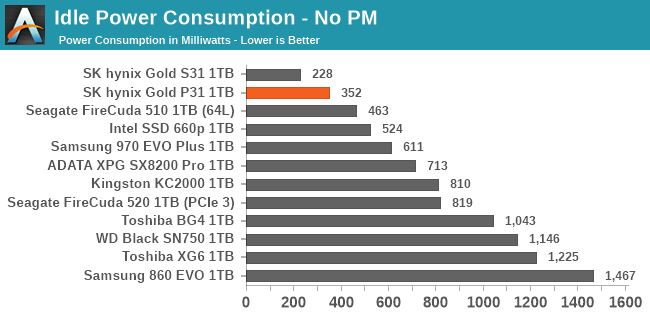
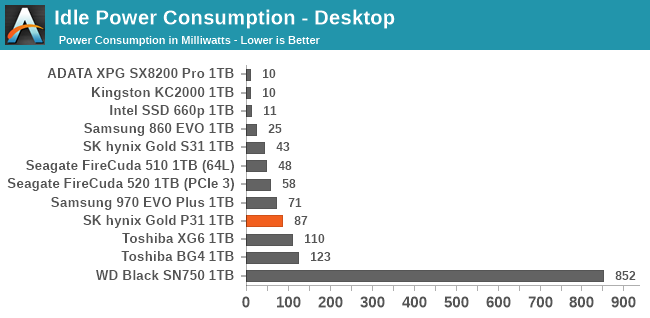
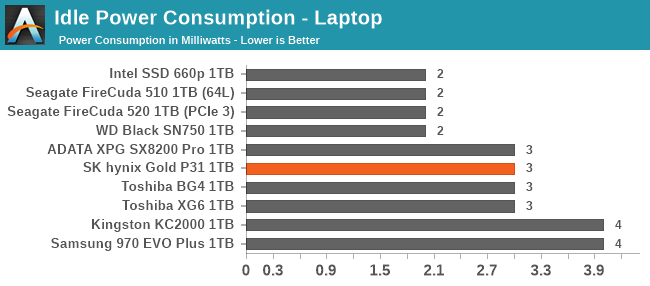
The SK hynix Gold P31 has fairly low active idle power consumption: even with PCIe link power management disabled, it doesn't take much to keep this controller awake. The intermediate idle power level that would be typical for many desktop systems is unimpressive, but 87mW is by no means a problem. With all the power management features turned on as should be the case for any properly-configured laptop, the P31's 3mW is competitive (and differences of one or two mW really don't matter here).
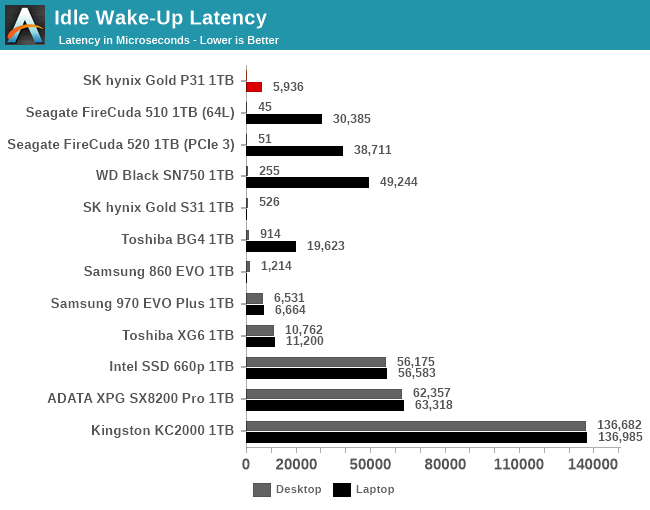
The SK hynix Gold P31 takes just under 6 ms to wake up from its deepest idle state, which is one of the fastest wake-up times we've measured from a drive that successfully enters a deep sleep state when instructed to. Wake-up latencies an order of magnitude higher are still common on many drives, especially those with Silicon Motion NVMe controllers. We were unable to measure any significant latency difference between our "desktop idle" settings and the active idle settings that disable all PCIe link power management; some other drives have been pretty close to this, with mere tens of microseconds delay.
Conclusion
I've rolled my eyes every time SK hynix uses their "4D NAND" moniker to describe their combination of a peripheral under cell layout and charge trap flash. It seemed like a silly exaggeration of a minor advance over other 3D NAND, especially since Intel and Micron have been doing "CMOS under the Array" since their first generation of 3D NAND. But now that I've tested a SSD using this "4D NAND" for the first time, I'll admit it's not purely marketing fluff. This is a genuinely impressive product, and the new 3D NAND seems to be a very important factor. In some very important ways, SK hynix has taken the technological lead, even if this position may not last long.
The SK hynix Gold P31 at first glance seems to be a fairly ordinary high-end NVMe drive, albeit still limited to PCIe 3.0 speeds. It offers well-rounded performance but sets few performance records for this market segment. The write endurance ratings are good and it hit the market with competitive pricing from day one. Taken together with last year's release of the decent Gold S31 SATA SSDs, this is enough to establish SK hynix as an important player in the retail consumer SSD market.
But that's not the whole story when it comes to the Gold P31. The drive's power efficiency is far above the competition; it uses less power than many SATA SSDs while delivering high-end NVMe performance. Thanks to good co-design of their 128L 3D NAND and their in-house NVMe SSD controller, SK hynix has completely redefined our standards for NVMe SSD power efficiency and turned in the most surprising benchmark results in my five years of working for AnandTech.
| High-End NVMe SSD Price Comparison August 26, 2020 |
||||
| 240-280GB | 480-512GB | 960GB-1TB | 2TB | |
| SK hynix Gold P31 | $74.99 (15¢/GB) |
$134.99 (13¢/GB) |
||
| ADATA XPG SX8200 Pro | $44.99 (18¢/GB) |
$69.99 (14¢/GB) |
$134.99 (13¢/GB) |
$249.99 (12¢/GB) |
| Inland Premium | $43.99 (17¢/GB) |
$64.99 (13¢/GB) |
$119.99 (12¢/GB) |
$234.99 (11¢/GB) |
| Team MP34 | $44.99 (18¢/GB) |
$66.99 (13¢/GB) |
$122.99 (12¢/GB) |
|
| Crucial P5 | $54.95 (22¢/GB) |
$79.95 (16¢/GB) |
$149.95 (15¢/GB) |
$339.95 (17¢/GB) |
| WD Black SN750 | $54.99 (22¢/GB) |
$69.99 (14¢/GB) |
$134.99 (13¢/GB) |
$329.99 (16¢/GB) |
| Samsung 970 EVO Plus | $69.99 (28¢/GB) |
$99.99 (20¢/GB) |
$189.99 (19¢/GB) |
$369.99 (18¢/GB) |
| Corsair Force MP600 | $109.99 (22¢/GB) |
$194.99 (19¢/GB) |
$379.99 (19¢/GB) |
|
Surprises like this are why I wish more SSD vendors would sample their OEM drives for review. The P31 is far from SK hynix's first NVMe SSD. It's just the first consumer NVMe SSD they're selling directly as a retail product. They have been manufacturing client NVMe SSDs for years for PC OEMs, but those never find their way onto our SSD testbed.
Some of the first M.2 PCIe SSDs (Samsung XP941 and SM951) were OEM-only products, shipping well before the launch of the retail 950 PRO. We've now seen about six iterations of Samsung's M.2 PCIe SSDs go across our testbeds (in part thanks to help from third-party suppliers who provided some of those OEM-only models for us to review), and because of that we can chart the evolution of their storage technology. But this SK hynix drive comes more or less out of the blue.
Western Digital's first in-house NVMe controllers were announced alongside a pair of OEM drives. The high-end one (SN720) was followed up by a retail counterpart (WD Black gen2) a few months later. I asked Western Digital for a sample of the entry-level OEM SN520 when they introduced that second-generation WD Black, but they couldn't sample it to me. Much later, the retail SN500 arrived and raised the bar for DRAMless SSD performance. More recently, Micron's 2200 series client SSD with their in-house NVMe controller was announced over a year before the Crucial P5 arrived.
Toshiba (now Kioxia) has been the exception; in the past few years they have sampled the XG5, XG6 and BG4 to show off new SSD tech before it makes it into retail drives. OEM SSD products are often managed by separate departments that don't have any PR budget beyond one or two press releases a year. These drives don't need aggressive marketing, but without any review sampling whatsoever we're clearly missing important parts of the picture of the overall SSD market. It's also nice when we can confirm that the drives being used by eg. Dell aren't crap badly in need of an aftermarket replacement.
Even though a close look at recent OEM NVMe SSDs from SK hynix may have tempered the surprise of the Gold P31, it's still an impressive product. It shoots right to the top of my list of recommended SSDs for laptops and finally erases the lingering power efficiency advantage of SATA SSDs, and as a result of that we're giving it one of our coveted Recommended By AnandTech awards.

SK hynix Gold P31: The New Standard for NVMe Laptop SSDs
The SK hynix Gold P31 provides a preview of what how the entry-level NVMe SSD market segment will advance over the next few years, especially as the high-end moves on to PCIe gen4. The Gold P31 still retains plenty of performance for almost all consumer use cases, and will be excellently comfortable sitting in a laptop.

